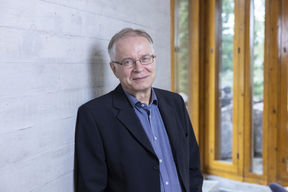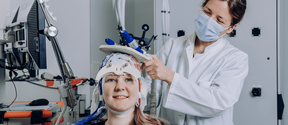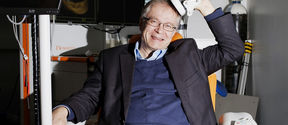ERC Synergy Grant worth €10M will help develop new techniques for brain research, disease diagnostics, and patient care
ERC Synergy Grant worth €10M will help develop new techniques for brain research, disease diagnostics, and patient care

Professor of Applied Physics Risto Ilmoniemi, Head of the Aalto University Department of Neuroscience and Biomedical Engineering, was appointed Aalto Distinguished Professor at the opening ceremony for the new academic year on the 7th of September. This title is awarded to professors of exceptional academic merit. Risto Ilmoniemi has focused his work on both the measurement of the brain's magnetic fields and magnetic stimulation. As part of his work to develop a new kind of brain stimulator, he obtained funding from the European Research Council (ERC) in 2018 for his ConnectToBrain project, becoming the first Finn to receive an ERC Synergy grant. The total size of the project is EUR 10 million, of which EUR 4 million was awarded to Aalto University.
‘I proposed magnetic stimulation research at New York University in 1986. It wasn’t until 1993–1994, however, when I came to the BioMag Laboratory at Meilahti Hospital, that I received support for my ideas, from one of the founders of the laboratory and pioneer of biomagnetism, Professor Toivo Katila and from my boss, Docent Pekka Karp. We then succeeded in getting funding for the project. Although my original idea of multichannel stimulation was not realised at that stage, we were soon one of the world's most important laboratories for magnetic brain research. Our new navigated brain stimulation method was also commercialised.’
In the summer of 2021, the ConnectToBrain research group completed the first prototype of their device. The new prototype can move the stimulated point from one part of the brain to another with a delay of just a few milliseconds. This allows the researchers to have an efficient wireless connection to neuronal network rhythms in the brain. The dream of electronically self-guided multi-site brain stimulation is finally beginning to materialise.
‘We want the device's software to develop features of artificial intelligence. This would allow it to decide for itself, based on simultaneous brain measurements, which stimulation sequence would best help the brain recover from, for example, deep depression or chronic pain. Soon we will start comparing the brain responses generated by multi-site stimulation between healthy people and patients. At the same time, we are initiating a new period of development work. Our aim is to have a device that can be used to control brain functions simultaneously in different parts of the head by 2025.’
Ilmoniemi began his studies in applied physics in 1975 at Aalto University's predecessor, the Helsinki University of Technology, following in the footsteps of his elder brother. He then obtained his postgraduate training at the university’s Low Temperature Laboratory under the supervision of Professor Olli V. Lounasmaa.
‘When I came as a summer programme student to the Low Temperature Laboratory on the ground floor at Rakentajanaukio in June 1978, I was told that everyone had to attend the coffee meeting at two o’clock each afternoon. I had studied six languages and it was amazing to hear all of them in the first meeting: Finnish, Swedish, English, Russian, German and French. The international dimension fascinated me, so I took as many as 20 hours of language lessons a week in the autumn alongside my other courses. Although my supervisor Olli Lounasmaa emphasised good language skills, I was afraid to tell him about how I was using my time; I thought I'd be fired. I was also rather shy in that group, and I don’t think I said more than a couple of words in any coffee meeting during the first year, not even in Finnish.’
After completing his master's thesis and doctoral dissertation at the Low Temperature Laboratory, Ilmoniemi moved to Manhattan to work as a postdoctoral researcher at New York University. After two years, he returned to his former research group, and then moved on from there in 1994 to Meilahti Hospital to work as Director of BioMag Laboratory.
‘The joint, interdisciplinary BioMag Laboratory has been a great success: we introduced technology developed at Otaniemi into the hospital, developed new technology, carried out a wide range of brain research, and created and introduced into the hospital new diagnostic and treatment methods.’
Nine years later, Ilmoniemi ended up as CEO of Nexstim, a company he had founded, which develops magnetic stimulation.
In 2006, Ilmoniemi was appointed as a professor at Helsinki University of Technology. He was first Head of the Laboratory of Biomedical Engineering, and has then been Department Head since 2008, except for the years he spent as Academy Professor from 2012 to 2016.
Like many of his colleagues, Ilmoniemi intends to continue his research for many years to come.
‘I have always liked studying and try to learn new things. I still believe that my best scientific achievements may be just around the corner—which keeps the mind alert,’ Ilmoniemi concludes.
Read more: President Ilkka Niemelä: ‘Cuts to research are always cuts to education’


ERC Synergy Grant worth €10M will help develop new techniques for brain research, disease diagnostics, and patient care

An Aalto-led team is developing new transcranial magnetic stimulation (TMS) technology to treat pain, depression and other neurological conditions. The aim is faster and more effective treatment.

Brain stimulation technology with its roots in Otaniemi is used as an aid in neurosurgery all over the world.



